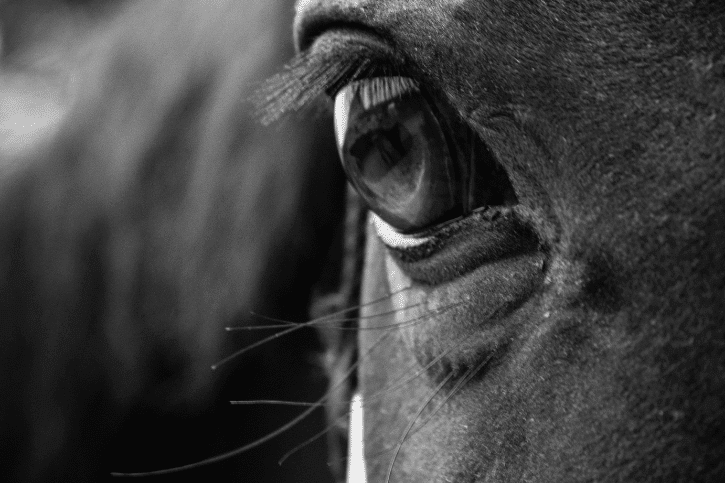Can Horses See Straight Ahead?
I was out with my son the other day tending to our horses in the field, and he’s at that stage now where he’s always asking questions about everything—which I don’t mind!
He’s always been naturally very curious of my horses, and the other day as he was standing in front of one of our horses, he asked me if it was able to see him standing there straight ahead of it.
I guessed it probably could, but it did occur to me that a horse’s eyes are in the side of its head rather than the front like ours.
So, I decided to look into it.
So, can horses see straight ahead?
Horses’ eyes being set in the side of their head means they have great peripheral vision, but they can’t see very well directly in front of them. Different horses have different visual acuity, but essentially, they are ‘prey’ animals and have eyes that scan for predators, rather than look ahead at fleeing prey.
So, horses can’t really see straight ahead, or at least not very well.
Herd animals of all kinds have their eyes set into the sides of their heads, and I’ll get into a bit more detail about why that is, and what a horse’s vision can mean for you as a horse owner.
Why can’t horses see straight ahead?
The traditional explanation for the position on the eyes of the heads of animals is all about what exactly they need their vision for, and this explanation still holds absolutely correct.
Horses are and have been prey animals for a very long time.
In some ways, it’s difficult to imagine what natural predators horses would have in most parts of the world given their size.
But, the fact is, horses were not always so large; they’ve actually been selectively bred by humans over the generations to reach the size they are today.
So, in the past, horses would have had a lot more predators to worry about.
So, if you look at more or less any herd animal, their eyes are pretty much always set in the sides of their heads.
It’s essentially a threat detection mechanism.
While the herd is grazing, they can all be constantly on the look out for threats from predators.
Compare this with the eyes of most predators, like, for example, any big cat.
Their eyes are set deeply in the front of their head.
Or, even just look in a mirror.
Our own eyes go straight ahead, and our peripheral vision is pretty poor, because we evolved from hominids that would chase prey across the plains of Africa.
So, how far can a horse actually see ahead of them?
How far can a horse see in front of them?
Horses’ vision differs greatly from our own, then.
Humans, in general, can see somewhere between 30 to 60 feet in front of us, depending on visual acuity.
There is a larger range but the typical person falls within that range.
Compare this with the average horse, who can only see about 20 feet in any direction.
So, directly in front of them, they can see very little; they do have a considerable blind spot.
This is why their threat detection mechanism only works if they’re part of a herd.
They need to have individuals looking in every direction.
Even horses racing are generally just running blindly ahead without really knowing what’s ahead of them.
Part of the instinct is the fact there are so many other horses around, and the whip actually simulates the touch of another horse.
They can certainly see all around their immediate environment unlike we can, but they struggle to see what’s directly ahead of them.
Another piece of advice often given is that you shouldn’t look a horse in the eye, so let’s look at why that might be.
Can you look horses in the eye?
Before we get into this, there are some caveats.
The fact is that horses get to know humans very well, and they can distinguish one from another.
Someone who’s been working with a horse for a long time probably doesn’t need to worry about the eye contact, and in fact some even advise it as a good thing.
However, if you don’t know the horse at all, making direct eye contact, or at least excessive eye contact, can be viewed as a threat by the horse.
Some even use direct, harsh eye contact as a form of admonishment, when the horse isn’t behaving as desired.
Try not to make too much eye contact before you know a horse well, then.
Furthermore, take into account the horse’s blind spots.
One of the main causes for horses kicking people is them being nervous with someone behind them.
They’ll know you’re there when straight ahead of them, as they might not see you in their direct vision but will be able to make you out.
Equine vision is quite amazing, then, though it is very different from our own.
Our own eyes more or less only allow us to see right ahead of us, with some degree of peripheral vision depending on the person.
Horses have more or less purely peripheral vision and struggle to see well ahead of themselves.
We are not really ‘predators’ as a species anymore, but the predator/prey distinction is the basic reason for this.
